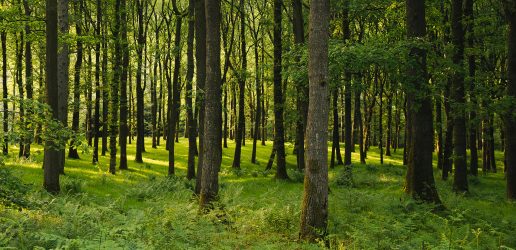
New research reveals the impacts of forest management for timber production on the carbon sequestration of a Sitka spruce forest and shows the impact of the 2018 drought.
Our climate is changing with global temperatures potentially rising 2 – 4 °C above pre-industrial levels by the end of this century. Trees and forests have an important role in mitigating climate change, and in helping reach ‘net -zero’ emissions targets. In the UK, it is estimated that in 2018 there was a net carbon dioxide (CO2) uptake (i.e. a sink) of 18 million tonnes by forests.
Coniferous trees, such as pines, spruces or firs, comprise approximately half of the UK’s forests; around half of those are made up of fast-growing Sitka spruce grown and harvested for a range of timber products. These forests are predominantly managed as even-aged, single-species plantations, using ‘patch clear-felling’ for harvesting and a growth cycle duration of less than 50 years.
This intensive management affects the forest carbon cycle, through changing the CO2 uptake of the trees and the release of CO2 and other greenhouse gases from the soil, and may determine how large a carbon sink forests are.

Research conducted by Forest Research recently published in the journal ‘Agricultural and Forest Meteorology’ quantifies the impact of the clear-felling and replanting management system on a typical upland Sitka spruce plantation on shallow peat soils. The researchers assessed the carbon balance, comparing a mature stand and a clear-felled site over a four-year period. The low rainfall of 2018 provided insights into the impacts of drought on the forest and felled areas.
The research shows that clear-felling resulted in a large initial CO2 release in the year post-felling, and this was quantitatively similar to the net annual CO2 uptake of the mature stand which was a strong sink. However, the growth of regenerating seedlings and ground vegetation reduced the net release of CO2 from the clear-felled area in subsequent years.
Importantly, in the third year after felling, the year of replanting, the clear-fell site reduced to being only a weak net source of CO2. We conclude that using the clear-felling and replanting management system for productive Sitka spruce stands on similar shallow peat soils is likely to start to recreate a carbon sink within 5 years of felling. However, the drought of 2018 in the fourth year after felling increased the net losses of CO2 at the clear-felled site by 28%, slowing down the carbon sink recovery. The drought also reduced the annual net CO2 uptake of the mature Sitka spruce stand by 30% compared to the previous 3 years, although it remained a strong carbon sink.
This research shows that the conifer timber production cycle on shallow peat soils can contribute to net-zero emissions targets. Further droughts may reduce the contribution of our forests to these targets, so understanding drought sensitivity is important in managing climate change risk.
Citation: Xenakis, G., Ash, A., Siebicke, L., Perks, M., Morison, J.I.L, 2021. Comparison of the carbon, water, and energy balances of mature stand and clear-fell stages in a British Sitka spruce forest and the impact of the 2018 drought. Agricultural and Forest Meteorology, Volume 306, 108437 https://doi.org/10.1016/j.agrformet.2021.108437.
Image: Monitoring greenhouse gas fluxes within a mature stand of Sitka spruce at Harwood Forest.

The British Woodlands Survey, 2025, which focuses on resilience launches.

Forest Research has released the results of the Public Opinion of Forestry Survey 2025 for England and the UK, Scotland and Wales.
New research has been published which explores how to enable and encourage access to woodlands for diverse members of the public.

The British Woodlands Survey, 2025, which focuses on resilience launches.

Forest Research has released the results of the Public Opinion of Forestry Survey 2025 for England and the UK, Scotland and Wales.
New research has been published which explores how to enable and encourage access to woodlands for diverse members of the public.